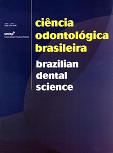Relação entre estado nutricional e alterações do esmalte dental em escolares de Botucatu-SP
DOI:
https://doi.org/10.14295/bds.2004.v7i1.475Abstract
Objetivo: identificar as possíveis associações dos defeitos de desenvolvimento do esmalte (DDE) de dentes permanentes com o estado nutricional de escolares de 7 a 10 anos de idade. Método: Foram examinadas 449 crianças por um único examinador para os DDE e exame antropométrico. A reprodutibilidade do índice DDE verificada pela Correlação de Pearson foi 90% de concordância intra-examinador. Para avaliação do índice de defeitos de desenvolvimento do esmalte dental foi utilizado o DDE (The Developmental Defects of Enamel Index) modificado por Clarkson & O’Mullane. O estado nutricional foi avaliado pela análise antropométrica considerando Peso/Estatura (P/E) e Estatura/Idade (E/I). As crianças foram classificadas como eutróficas (E/I > 95%; P/E > 90%), desnutrição atual (E/I > 95%; P/E £ 90%), desnutrição pregressa (E/I £ 95%; P/E > 90%), desnutrição crônica (E/I £ 95%; P/E £ 90%). A etiologia das DDE quanto à origem foi classificada em sistêmica (dentes homólogos afetados) e local (dente isolado afetado). As associações entre estado nutricional e as variáveis: intervalos de dentes afetados e etiologia dos DDE foram submetidos ao teste de Goodman (p< 0,05). Resultados: A prevalência das DDE foi 73,9% e 34,07% de desnutrição. O tipo de lesão mais frequente foi a opacidade difusa nos dentes anteriores (incisivos) e opacidade demarcada nos posteriores (primeiros molares). As crianças classificadas como eutróficas apresentaram maior número de dentes afetados em relação às desnutridas (p<0,05).Houve diferença estatisticamente significativa entre as desnutridas e eutróficas em relação aos dentes afetados e não afetados. Observou-se diferença estatística significativa entre o fator etiológico sistêmico e o local. Conclusão: Embora a etiologia destas lesões tenham sido atribuídas à natureza sistêmica, não houve associação significativa entre os diferentes estados nutricionais e a presença de lesões de esmalte (p>0,05).
Downloads
Downloads
Published
How to Cite
Issue
Section
License
Brazilian Dental Science uses the Creative Commons (CC-BY 4.0) license, thus preserving the integrity of articles in an open access environment. The journal allows the author to retain publishing rights without restrictions.
=================




























